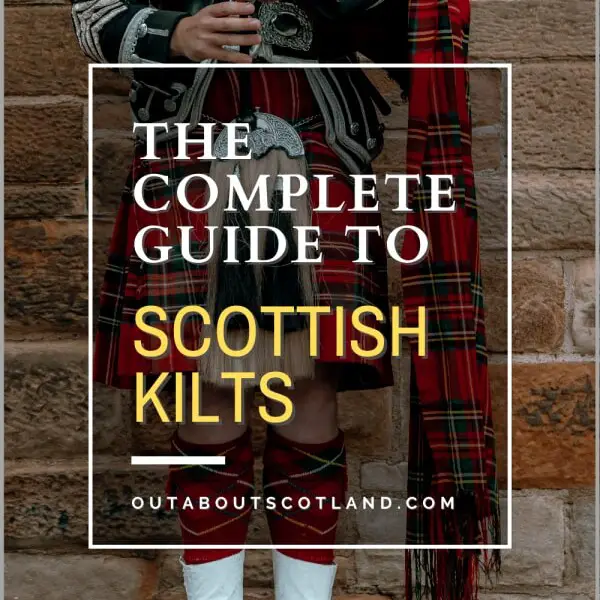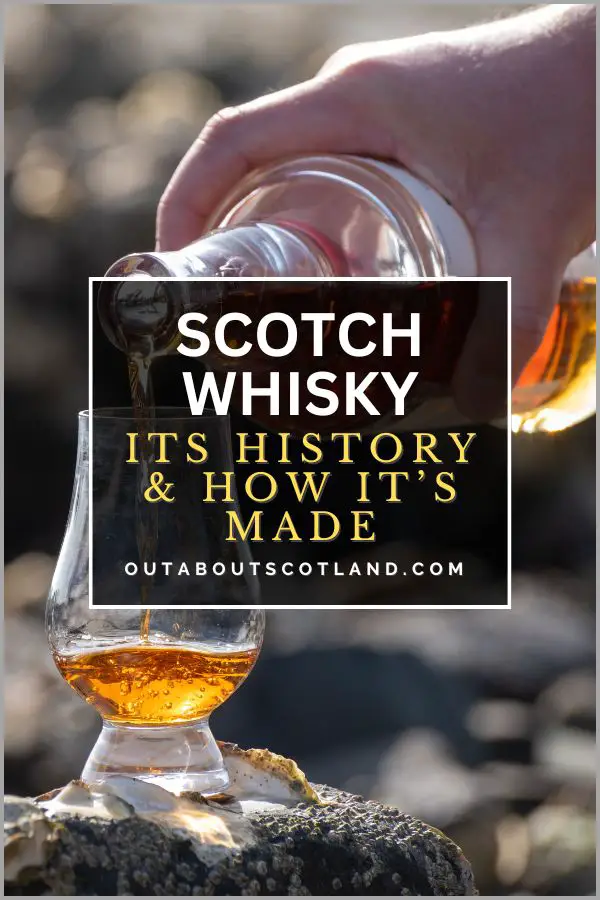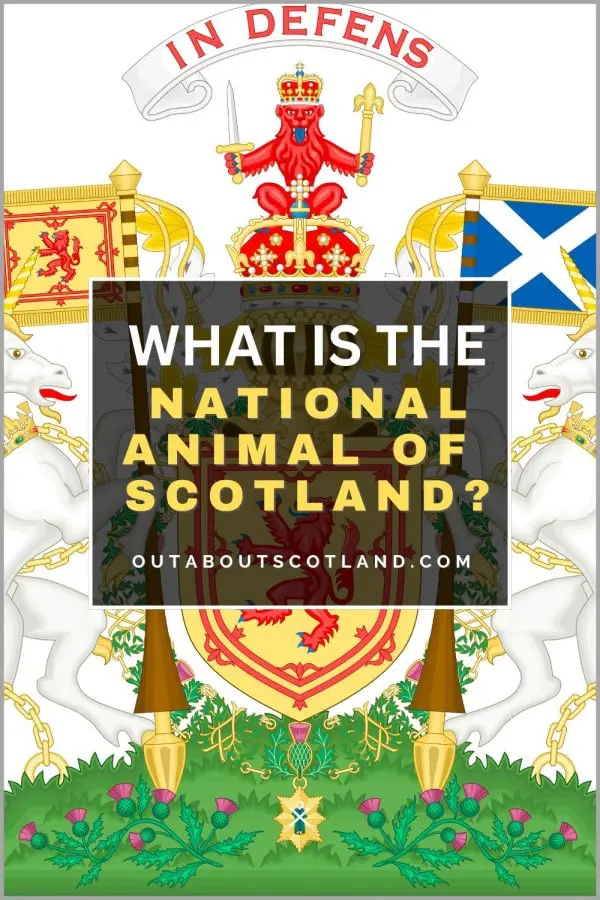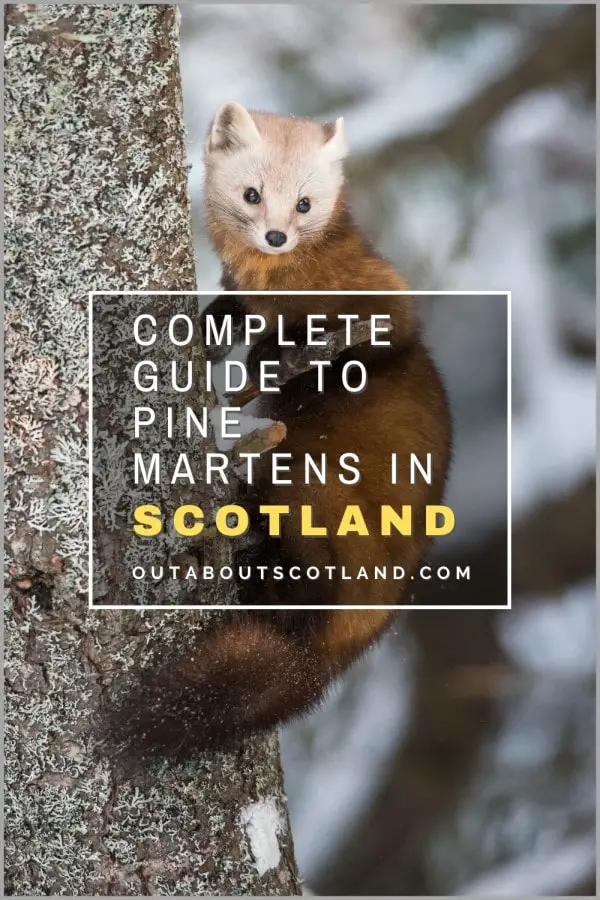The Scottish kilt is one of the most recognisable items of traditional clothing in the world. This warm, smart, and durable garment is frequently worn at weddings, and it’s the only national dress in the UK that’s worn for ordinary purposes as well as special occasions. Discover the history behind Scottish kilts as well as their modern-day use, and learn exactly how to wear them and which accessories to wear with them in this ultimate guide.
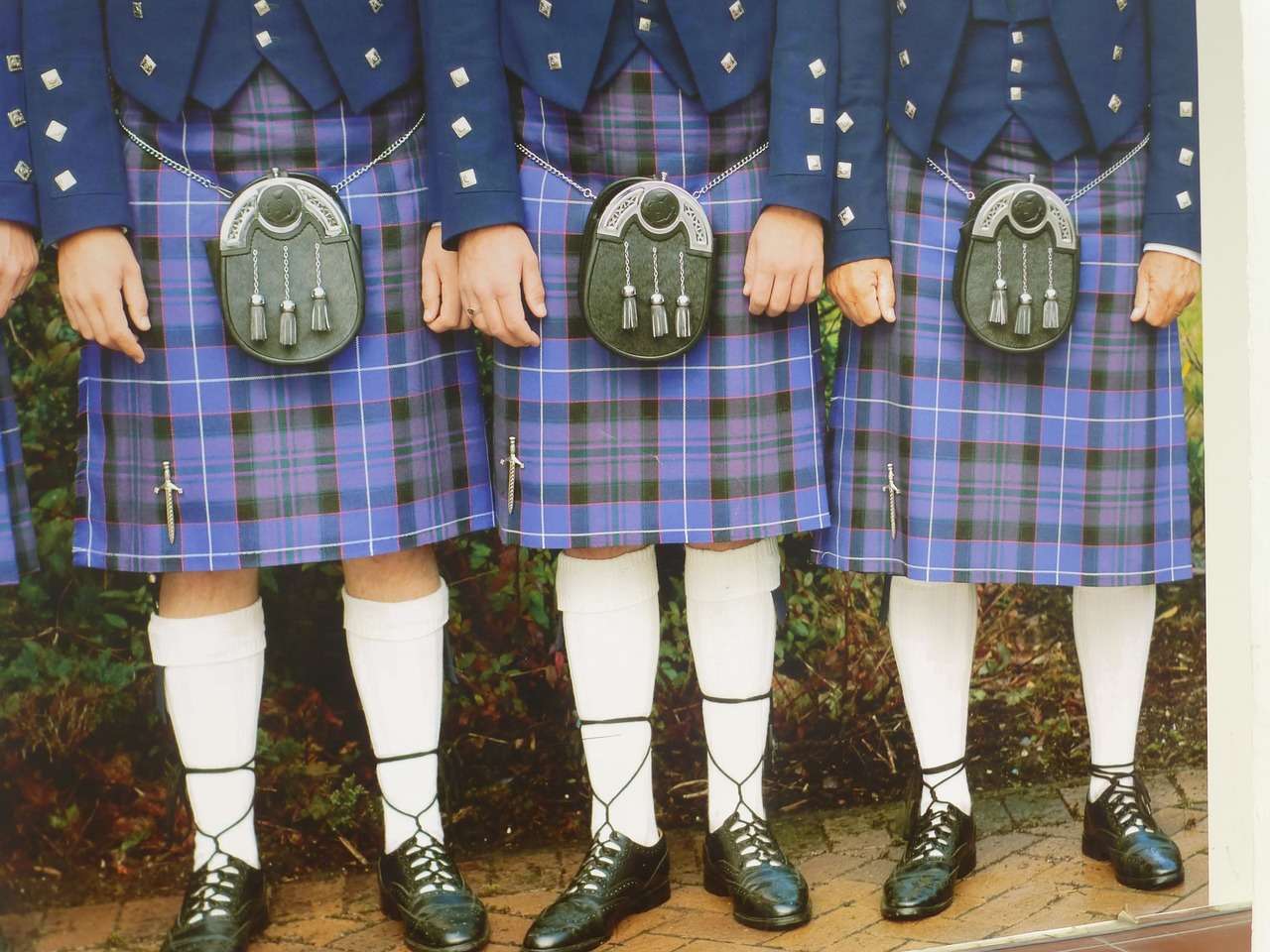
What Is a Scottish Kilt?
A kilt is a knee-length men’s dress skirt that is often worn on formal occasions like weddings, but it can also be worn at semi-formal events such as Burn’s Night and Hogmanay. The modern kilt originated from a length of cloth called a Feileadh Mor that was worn extensively in the Scottish Highlands in the 16th century.
Also known as the great kilt, it consisted of a length of material that wrapped around the wearer’s waist and was draped over the shoulder, offering protection against the temperamental Scottish weather. This design developed into the modern kilt, which still wraps around the waist but does not drape over the shoulder.
Kilts have seen a resurgence in popularity in recent years, with fashion houses designing versions that use modern materials such as denim with built-in pockets, unlike traditional kilts that have no pockets at all. While informal kilts have plain designs, the traditional kilts worn at weddings are almost always made from a material that features a clan tartan, and they are accompanied by a number of decorations, including kilt pins and decorated sporrans.
What Is a Scottish Wedding Kilt?
A kilt is a multi-functional item of clothing that works equally well on occasions ranging from traditional dances to formal gatherings, but it’s most commonly associated with weddings. If you’ve already attended a Scottish wedding, you’ll know there are no hard and fast rules on what to wear, and unless there’s a specific request from the married couple, you can quite happily wear a standard suit, but most Scots, given the choice, will usually opt for a full-kilt outfit.
These wedding kilts are much the same as you’ll see at other events, but they’re accompanied by an assortment of accessories, including a jacket, waistcoat, tie or bow tie, sporran, knee-length socks, and ghillie brogues. Wedding kilts can be classified as either formal or semi-formal, and there are significant differences between them, so depending on your circumstances, you might consider buying one or the other.
If you have Scottish roots and don’t already own a kilt you will likely want to hire one that has your clan’s tartan, but be aware that not all kilt rental shops will be able to supply every design so you may have to bite the bullet and have your kilt made to order.
These can cost upwards of £500 for an 8-yard 100% wool kilt, but it will last a lifetime so it should be viewed as an investment that will be worn for many years to come.
Alternatively, you can buy stock kilts that use the same quality material but are produced in greater numbers as they feature a generic coloured tartan pattern that isn’t specific to any clan. They are much cheaper and can be purchased new for around £300, or around £100 for an ex-rental.
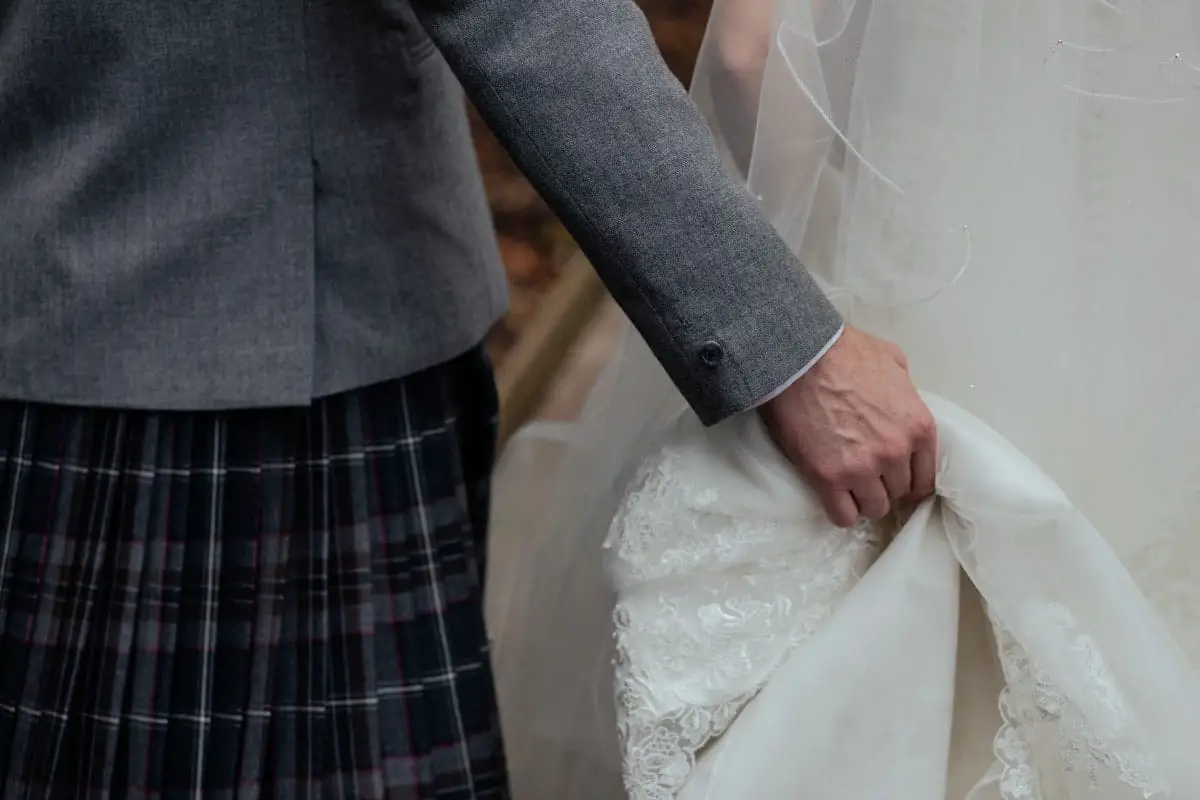
Types of Scottish Kilt
The traditional formal wedding kilt outfit consists of a kilt and a Prince Charlie jacket with a matching waistcoat. These jackets are characterized by three square buttons on each cuff and three on each side of the jacket opening, with smaller, matching buttons on the lapels and the waistcoat.
The waistcoat has three buttons that sit around an inch from each other which fasten low down on the stomach allowing a large section of the shirt to be on display.
The Prince Charlie jacket hangs low at the back but sits high at the front and looks quite similar to a tuxedo in many ways. However, unlike Argyll jackets (see below), the groom frequently wears them with a fly plaid, which is a tartan cloth that drapes over the shoulder. The outfit is finished off with a wing collar shirt and a bow tie, or alternatively, a cravat.
Semi-formal, also known as Argyll, kilt outfits include the same kilt as you would wear with the Prince Charlie outfit, but with a differently tailored jacket. Argyll jackets don’t sit as high at the front and aren’t as long at the back, which makes them feel more like a standard suit jacket. They also usually have three buttons on the sleeve, but unlike Charlie, Argyll jackets are worn with a waistcoat that features five buttons that fasten from the chest down to the stomach.
The material of the jacket and waistcoat will match in colour but strictly speaking, you don’t have to wear a waistcoat with an Argyll jacket, especially if it’s an informal wedding and the venue is warm. That being said, if you want to dress it up a little you can always replace the usual matching necktie with a wing collar shirt and a black bow tie.
As far as accessories go, they’re broadly the same between Prince Charlie and Argyll outfits except for the belt and buckle on the latter and the fly plaid on the former.
They both include ghillie brogues (see further down this page) or normal brogue footwear, a kilt pin, a sporran, sock flashes and a sgian dubh. None of these items are mandatory except for a sporran which is almost always worn with a kilt at weddings.

How to Wear a Scottish Kilt
If you’ve never worn a kilt before, putting one on can seem like a daunting task, but once you’ve practised it a couple of times it becomes second nature. To be honest, no order has to be adhered to when dressing in a kilt, but having attended lots of weddings, I now have my own weddingding routine that works best for me.
The fundamental part of the outfit is the kilt, but before you get dressed in it, put your shirt on and button it to the bottom, keeping the neck untied for now. Take your kilt and unbuckle it so it opens out into one piece of material. You’ll notice one section is pleated and one is flat, so you’ll want to position the pleats to your rear.
Hold the kilt behind you and with your right hand pull the material tight so the right-hand edge is level with your left leg. Then pull the other side in front of you with your left hand and position the kilt so that the pleats are central to your back.
The buckle in your right hand fastens to the strap on the mid-left-hand side of the kilt, and the buckle on your left hand fastens to the right side of the kilt. Hopefully, you’ve already had your kilt tailored for the correct fit so that it’s snug but not too tight, and ideally, you should be able to fit two fingers under the waistband.
With regard to length, the bottom of the kilt should sit at the bottom of the knee, with the top of the waistband sitting above the navel.
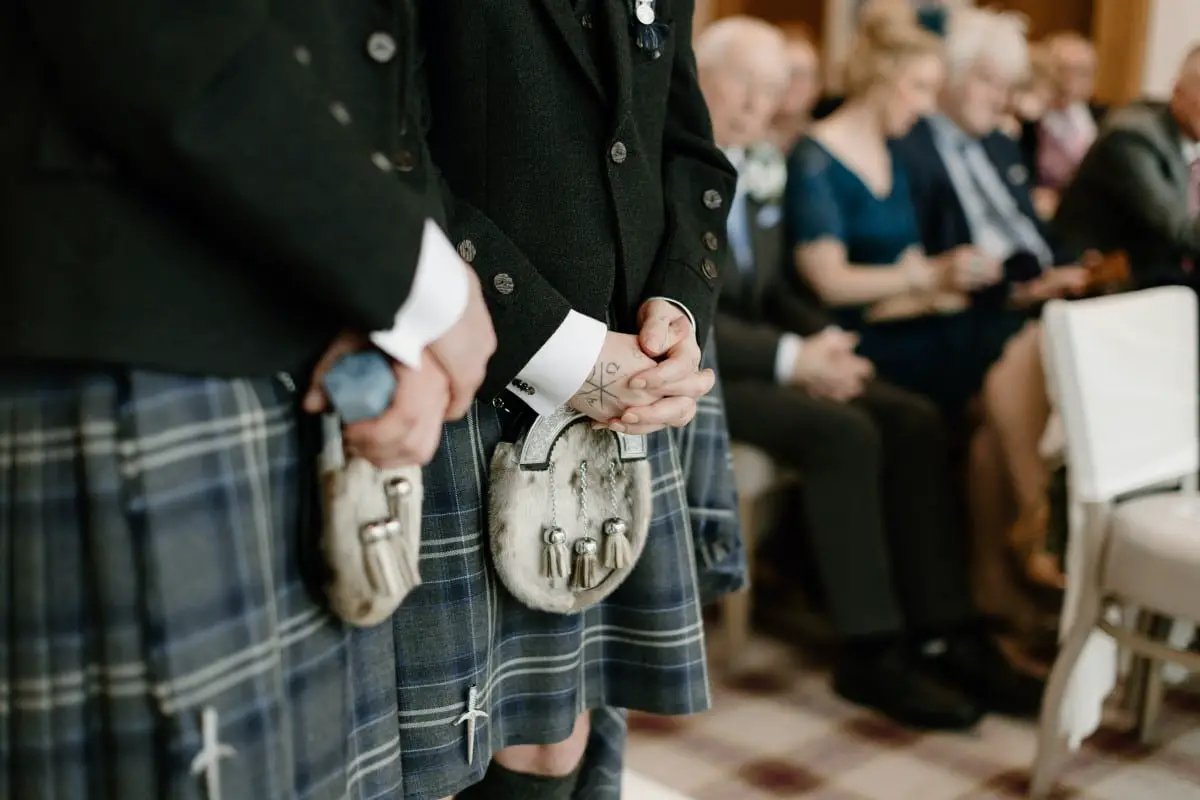
Now is a good time to fasten the remaining shirt buttons and secure the tie or bow tie depending on the type of shirt you’re wearing. Just like a suit or tuxedo, wear a wing collar shirt with a bow tie and a standard collar with a necktie. If your shirt has buttonholes on the cuffs, don’t forget to secure the sleeves with cufflinks.
The waistcoat can now be worn, and it’s customary to secure all buttons on a Prince Charlie jacket but leave the bottom button unfastened on an Argyll waistcoat. This isn’t exactly a rule, though, so feel free to secure all buttons if you prefer.
Before pulling on your jacket you should fasten your belt and buckle if you’re not wearing a waistcoat, but note that it’s not usual to wear a waistcoat and a belt and buckle together.
It is usual to wear a sporran though, and in fact it’s absolutely necessary as there are no pockets on a kilt so if you’ve driven to your event you might find yourself short of somewhere to stash the car keys without one. They’re self-explanatory to fit as the sporran has a length of chain on either side that simply wraps around the waist and goes through loops at the back of the kilt.
The chains will have a clasp that holds them together and if fitted correctly the sporran will hang down around 6 inches from the top of the kilt. An optional accessory is a kilt pin, which in years gone by was a weighted decoration that held the material in place to stop it flapping about.
- Scottish Thistle Kilt Pin
- This solid steel kilt pin has a chrome finish and is perfect for any Scottish Highland outfit.
- Stainless steel
- Measure approx. 4" long
- Visit our store for more kilt products and other scottish gifts
These days the pin is purely ornamental and is usually in the shape of a sword. It’s positioned with the pointed end facing down 5 cm from the side of the kilt and 10 cm from the bottom, as close as possible to one of the lines on the tartan. Note that the pin is pushed through the top layer of material only, not all layers.
As far as socks go, they’re pulled up to the bottom of the knee and then folded over so that the calf is completely covered and there’s a gap of three or four inches between the top of the sock and the bottom of the kilt. Due to their length, you cannot wear standard socks with a kilt, so you must purchase special kilt socks that are long enough to pull up as far as your knees.
Pull the socks as high as they will go, and note the point where you’ll fold them over, as that’s where you’ll place the sock flashes. These flashes usually match the kilt material, but they can also be a contrasting colour if you prefer, and they serve two purposes.
The first is they add extra decoration to the outfit, and the second is they are secured with an elasticated band that stops your socks from falling down. The flashes are secured with a clip at the back of the leg and the material is positioned on the outer side of the calf. The sock is then folded over the elastic so that the flash protrudes a couple of inches underneath.
The final decorative touch is the sgian dubh, which is a wee dagger that sits inside a sock depending on whether you’re right or left-handed (left-handed,left sock, right-handed, right sock). Push the sgian dubh blade into the sock on the outside of the leg so that only the handle can be seen.
I’ve created a separate section about tying ghillie brogues so if you have them look further down this page, but if not lace your shoes as normal.
The final component of the outfit is the jacket, which is worn unbuttoned and left to hang open at the front. Depending on the event, you may have a floral brooch to pin in place, but if not, that’s the ensemble finished.
What to Wear Under a Scottish Kilt
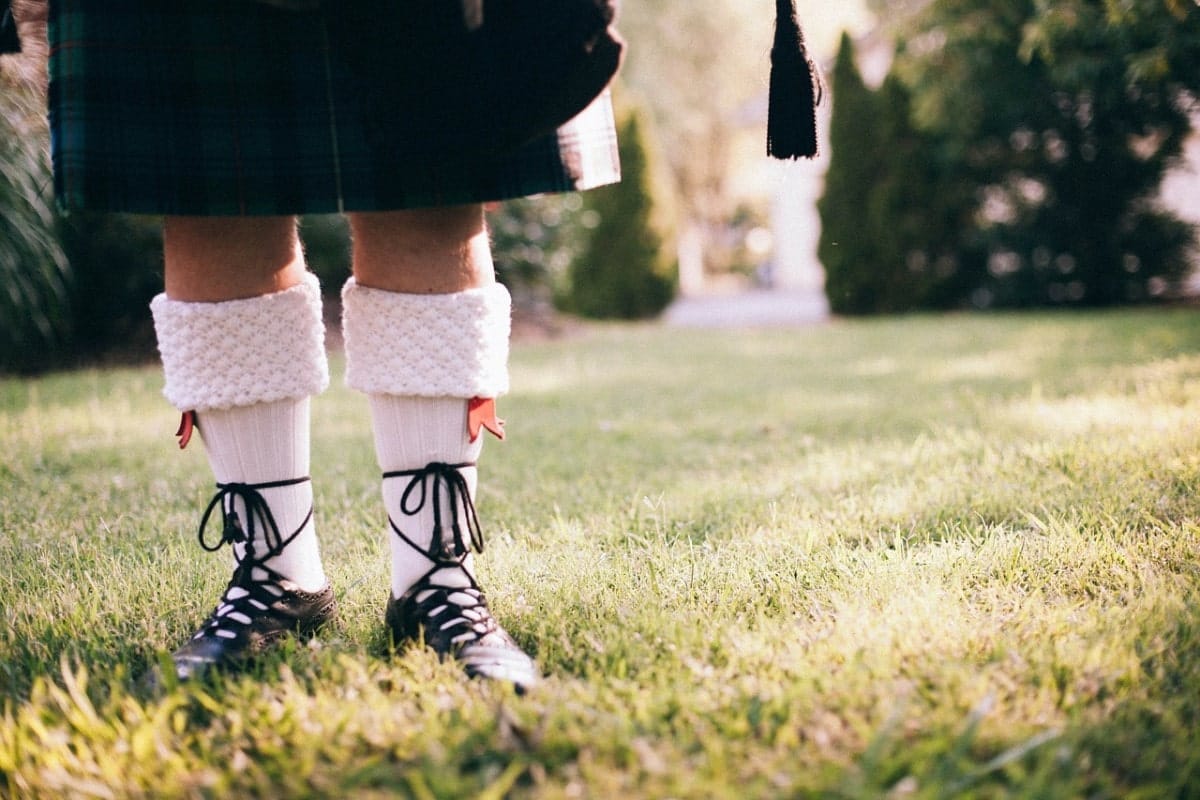
The easy answer to ‘what should I wear under a kilt’ is… well, wear whatever you like. Historically though, the traditional underdress of kilt wearers is socks and shoes… and nothing else. It’s believed that the Scottish penchant for wearing nothing goes back to the Highland regiments, who first authorised the kilt as their main uniform.
At the time, there was a strict dress code that explicitly detailed exactly what a soldier should or shouldn’t wear, but the first revision had no mention of what to wear under the kilt. The soldiers took this as an order that they were to wear no underwear at all, and before long it became a tradition – hence the phrase ‘going commando’.
There’s a wee bit of debate that goes on to this day as to what should or shouldn’t be worn under a kilt, but it basically comes down to whatever you feel comfortable with and what the circumstances are. If you’re going to a party where you’ll end up dancing the night away and your kilt is going to be flapping in the breeze for all to see, it’s probably best to wear something underneath it.
The Scottish Official Board of Highland Dancing has made the wearing of underwear compulsory at their events, and the Scottish Tartans Authority has decreed that not wearing underwear under a kilt is “childish and unhygienic,” so there’s plenty of sentiment to suggest you should cover up. However, if you do decide to let it all hang out, you need to be mindful that when sitting down, it’s possible for the kilt to rise up, and sitting cross-legged is just plain wrong in a man’s kilt.
Something else to be mindful of is whether you own your kilt or you’re hiring it as virtually all rental shops ask their customers to wear underwear with their hired clothing. The kilts are always dry-cleaned after each rental so realistically you could twist the rules a wee bit, but I guess that depends on the conscience of the individual.
Also, if you purchase a cheap kilt made from flimsy material – basically any kilt from a souvenir shop – I suggest you wear something underneath it, just to be on the safe side when the wind picks up. If you do decide to cover up, you can wear the same as you would jeans, shorts, or formal trousers, so Y-fronts, boxer shorts, or whatever underwear you normally wear will suffice.
You could wear a thin pair of shorts on top if you’re going to be spending any amount of time outdoors in the colder months, but I’ve always found myself getting too hot when I’ve worn shorts under a kilt indoors (which is something to bear in mind at a wedding reception).
How to Tie Kilt Shoes
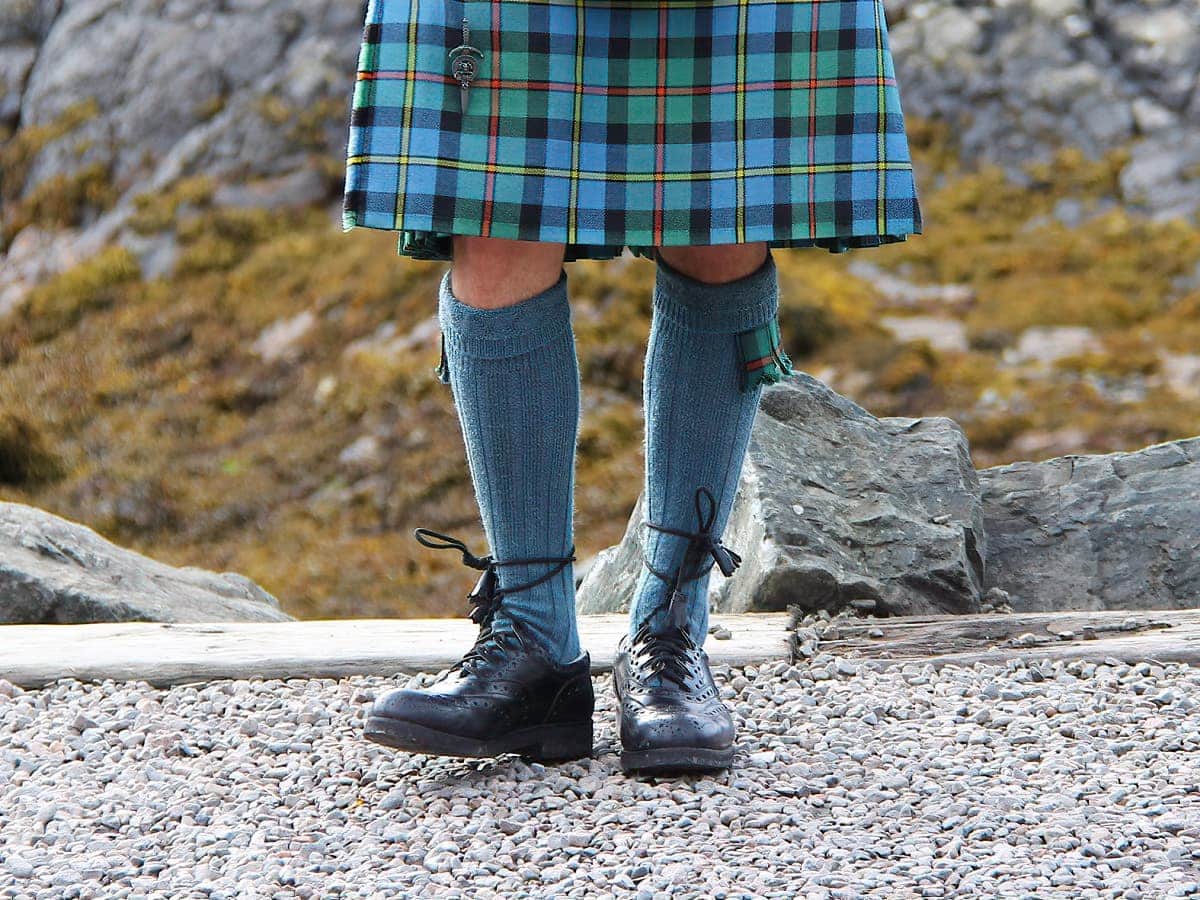
There’s no hard and fast rule when it comes to the style of shoes to wear with a Scottish kilt, but they should generally be formal, made of leather, and be either black or brown.
The preference tends to be brogues (leather shoes with decorative perforations on the uppers) but you can wear plain ones as well, and in fact that’s exactly what I wear myself as they double-up for use with a normal suit. However, if you really want to complete your kilt outfit with traditional footwear, you need to get yourself a pair of ghillie brogues.
These differ from normal brogues in a couple of major ways. First off, there’s no tongue so your foot lies directly against the eyelets and laces, and your sock is visible. The sock is usually thick and woollen and is calf-length with two inches rolled over at the top. There’s no ruling when it comes to colours but black, grey and white are most commonly worn.
The second difference of ghillie brogues is that the laces are not tied against the top of the shoe and are instead tied around the calves with long tassels that are wrapped around each sock.
It takes a bit of getting used to, but here’s a step-by-step guide to lacing up ghillie brogues:
- Thread the laces through each eyelet as you would a normal pair of shoes, but cross them over in an X, don’t thread them straight across like a pair of trainers.
- Pull the laces tight, then twist them around each other 4-5 times.
- Take the laces around the back of your calf, 3 inches above your ankle. Give them 3 twists, then bring the laces back around to the front of your shin.
- Tie the laces with a simple bow, just as you’d tie any normal pair of shoes. The bow is traditionally tied on the outside of each leg, but you can also tie it at the front of your shin if you prefer the look.
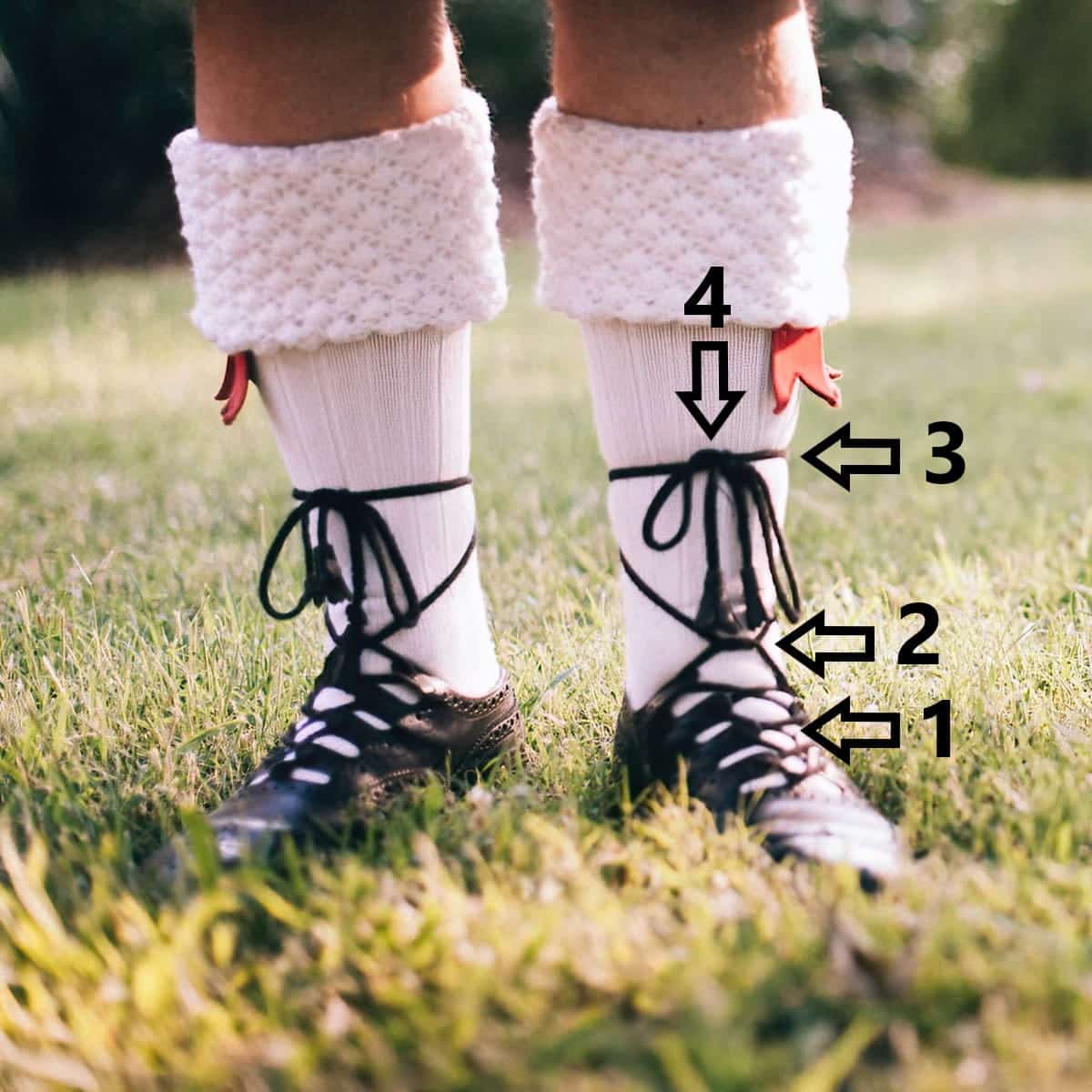
What Do You Wear With a Kilt?
There aren’t any set guidelines when it comes to accessorising a kilt, but there are a couple of staples that, if not worn, will make you stand out like a sore thumb. First and foremost, you must wear an appropriate jacket, and that means you cannot recycle a jacket from one of your old suits.
A kilt jacket sits much higher on the hips than a standard suit jacket, and it curves towards the navel, making the sporran the centrepiece of the outfit. A standard suit jacket, meanwhile, is designed to be worn buttoned down, meaning it will almost completely hide the sporran. The same rules apply for waistcoats, and again, you cannot wear a normal suit waistcoat with a kilt.
In addition to the correct jacket, wearing a sporran with a kilt is another must-have accessory if you’re attending any type of formal event in Scotland. While it’s acceptable to wear a modern kilt made from denim or *shudder* leather without a sporran in a casual situation, they’re a necessity for traditional events like weddings.
Other than those two items you’re pretty much free to accessorize your outfit however you like, and many people choose to add pieces over time rather than buy everything up front which can easily cost £1,000 or more for a top-quality kilt ensemble.
Here’s a list of all the accessories that can be worn with a semi-formal kilt that will be appropriate for the majority of occasions.
Sgian Dubh. The sgian dubh is a small knife that was originally used as a multi-purpose tool and also as a weapon. Its small size meant that it could easily be hidden out of sight, so it was considered polite to display the knife in the band of the sock when entering someone’s house. This tradition of keeping the sgian dubh in the sock continues to this day.
Ghillie Brogues. Traditional Highland dress shoes developed from 16th- and 17th-century buckled shoes into brogues that are similar to what we wear in modern times. Although normal brogues can be worn with a kilt, the traditional ghillie brogue with its long calf laces is often worn instead (see above for tying instructions). For formal events, black or brown leather is the preference.
Sporran. The first sporrans were large pouches made from animal skins that served the sole purpose of acting as a pocket. With the widespread acceptance of the kilt in the 1700s they became fashionable items for people of importance who had their sporrans inlaid with brass or silver.
Today, they are made from animal skins ranging from leather to sealskin, with prices ranging from £50 for a casual day wear sporran to £2,000+ for a formal dress sporran inlaid with silver.

Kilt pin. This small piece of jewellery is purely ornamental and is usually made from pewter or sterling silver. The pin is pushed through the top layer of the kilt on the bottom of the right-hand side apron. Prices range from £30 for a basic pewter Claymore sword design to £300+ for the same design in silver.
Kilt socks. When modern kilts were designed in the 1700s, they were often worn with socks made from offcuts of the kilt material, but the arrival of Scotland’s cotton mills in the 18th century meant knitted socks became the norm as they were more comfortable and cheaper to manufacture.
Modern kilt socks tend to be grey, black or white but can also be knitted in a matching tartan design. Basic socks start at around £20 but can rise to £300 for obscure tartan patterns.
Tie. There are two main types of tie worn at formal events in Scotland – the bow tie and the plain necktie. Bow ties are normally worn with a wing collar shirt and a Prince Charlie jacket, but they can also be worn with an Argyll jacket. However, the preference for all but the most formal occasions is to wear a necktie that is the same material and tartan design as the kilt.
Sock flashes. These small strips of material are attached to an elastic strap that sits under the rolled-over band of the sock. The flashes are positioned to sit on the outside of the leg and are usually made from the same material and tartan colours as the kilt.
Cufflinks. These are another optional accessory that are only required if your shirt cuffs have separate buttonholes. There are an almost limitless number of designs but they are almost always made from pewter or silver.
Kilt carrier. Most quality kilts will be supplied with their own kilt carriers which are used to protect the outfit in storage as well as during travel. Ex-hire kilts are often supplied in bags that are thin and prone to ripping, so spending £50 on a quality carrier that protects your outfit is a worthwhile investment.
How Much Does a Kilt Cost?
Like any other item of clothing, kilts can vary in price wildly depending on the quality of the material and the accessories that are included with it. There are also vast differences between retailers, so expect to pay twice as much for a kilt purchased from a tourist trap shop on Edinburgh’s Royal Mile than you’d pay for the same item from a small town kilt outfitter.
My advice, therefore, is to buy your kilt in person at a reputable kilt shop away from the tourist areas. I’d also advise against an online retailer, as there’s no substitute for feeling the material in your hand and seeing how the complete outfit looks after it’s tailored.
In the following table you’ll find the average prices for kilts from budget to premium quality levels that can be purchased from any decent high street retailer. All kilts are priced as new, but you can also get the exact same outfit as an ex-hire from many kilt rental shops for less than half the price.
| Style: Budget kilt outfit Expect to pay: £210 | Includes: |
| Men’s 8 Yard Polyviscose kilt | |
| Leather day sporran | |
| Leather sporran chain | |
| Men’s ghillie shirt | |
| Men’s kilt hose socks | |
| Thistle belt buckle | |
| Men’s leather belt | |
| Imitation sgian dubh | |
| Men’s ghillie brogues | |
| Style: Off-the-peg Argyll kilt outfit Expect to pay: £310 | Includes: |
| Men’s black Argyll jacket | |
| Men’s 8 yard Polyviscose kilt | |
| Full dress calfskin sporran | |
| Leather sporran chain | |
| Men’s kilt hose socks | |
| Ghillie brogue kilt shoes | |
| Men’s kilt flashes in matching tartan | |
| Claymore kilt pin | |
| Imitation sgian dubh | |
| Style: Premium handmade Argyll kilt outfit Expect to pay: £650 | Includes: |
| Men’s Argyle kilt jacket – 15 oz wool | |
| Semi dress sporran | |
| Sporran chain | |
| Grained kilt belt | |
| Kilt buckle | |
| Pewter thistle kilt pin | |
| Men’s shirt | |
| Black bow tie or Ruche tie | |
| Men’s kilt hose | |
| Wool sock flashes in matching tartan | |
| Black ghillie brogues | |
| Stone top sgian dubh | |
| Style: Off-the-peg Prince Charlie kilt outfit with fly plaid Expect to pay: £325 | Includes: |
| Men’s black dress Prince Charlie jacket and 3 button waistcoat | |
| Men’s 8 yard Polyviscose kilt | |
| Full dress calfskin sporran | |
| Leather sporran chain | |
| Men’s kilt hose socks | |
| Ghillie brogue kilt shoes | |
| Men’s kilt flashes in matching tartan | |
| Claymore kilt pin | |
| Imitation sgian dubh | |
| Men’s tartan fly plaid | |
| Plaid brooch | |
| Style: Premium handmade Prince Charlie kilt outfit with matching fly plaid Expect to pay: £910 | Includes: |
| Men’s Prince Charlie jacket 15 oz wool | |
| Coatee vest 15 oz wool | |
| Tartan fly plaid | |
| Stone topped plaid brooch | |
| Full dress sporran | |
| Sporran chain | |
| Kilt Belt | |
| Highland swirl buckle | |
| Men’s heavyweight kilt hose | |
| Tartan flashes | |
| Premium ghillie brogues | |
| Stone top sgian dubh |
How Are Kilts Made?
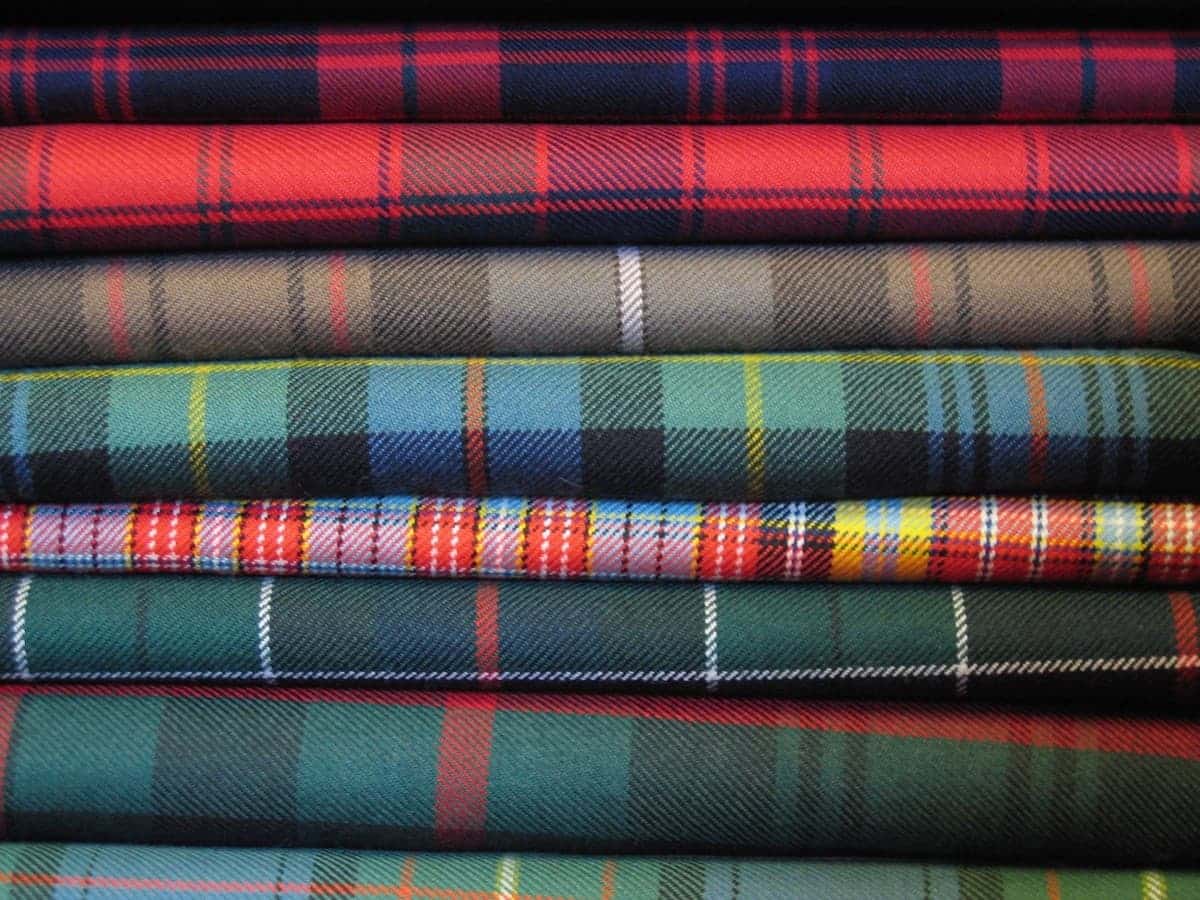
Traditional Scottish kilts are either hand or machine-made depending on the quality and how tailored it is. While you can pay upwards of £500 for a hand-made item that features a specific tartan, most people choose a machined kilt that is bought off the peg and then tailored to fit.
Whether hand-made or machine-sewn, the highest-quality kilts use 8 yards of material while the lower-quality kilts use 5 yards. That might not sound like a big difference but in reality, it’s quite noticeable and a full 8-yard kilt will hang better and have much deeper pleats at the back.
The reason hand-sewn kilts are so expensive is due to the amount of material that needs to be sewn, with each one taking up to 30 hours to make. In addition to the pleats, all kilts have a tartan design, which frequently isn’t a uniform pattern. That means it’s a skilled job to get the stripes aligned on the pleats, and that’s why the top-rated kilt-makers have at least 20 years of experience.
The width of the tartan relates to how wide the loom is, so in days gone by, the majority of kilts were 26–30 inches wide, as that was the width at which Scottish looms produced cloth. This tradition continues today and you’ll find most kilts are now 30 inches wide.
To make the kilt, the looms are set with coloured threads in the pattern of the chosen tartan. In the past, hand darning would take several days for each bale of cloth, but today’s computer-controlled looms pull each thread into the proper position in a matter of minutes.
With the cloth ready, the kilt maker lays it out and measures a length on the inside apron that’s as wide as the wearer’s navel to the middle side of their leg. From that point, they pull the material on top of itself in a series of pleats that are an inch wide, with the entire pleated section being 16 to 20 inches wide and the rest of the material lying flat.
The pleats are ironed and pinned in place, and a seam is sewn an inch from the top of the material, with another seam sewn six inches below the first. A backing felt is then stitched into the waistband, along with a lining that’s 4-5 inches wide. Leather straps with buckles are sewn into the material just below the waistband and below the lower seam, and the kilt is finished by giving the pleats a steam press.
What Is Scottish Tartan?

Tartan is a type of chequered cloth that features a design with crisscrossed lines of multiple colours. The material can be used for any item of clothing but it’s most often associated with the kilt.
The very earliest tartans were of a simple check design that used natural light and dark wool, but it wasn’t until the 17th century that the tartans that we recognise today were created. While tartans are now associated with specific clans, their origins developed from the weavers of each area of Scotland, who developed their own style of making cloth.
These cloths varied in checks and colours so the clans of each region became associated with the designs of the weavers in their region. The designs weren’t explicitly reserved for each clan though, and in fact, many Highlanders wore clothing that featured several tartan designs.
It wasn’t until the Jacobite uprisings of the 1700s that each clan became associated with their own specific tartans. After the battle of Culloden in 1745, Scots were forbidden from wearing tartan colours except for the army, which designed different tartans for each regiment.
When the tartan-wearing ban was repealed in 1782 there was a revival of interest in Scottish culture so the tartan-making industry designed new tartans for each clan to cash in on this newfound Scottish romanticism.
There are now at least three different tartan designs for each clan – dress tartan, hunting tartan, and mourning tartan – and they’re usually quite different from each other. The new tartans of the late 1700s were formalized by being officially named and registered to each clan in 1815, and they’re still associated with the same clans today.
In total, there are in the region of 7,000 different tartans. There is no law on which tartans you can wear but it’s considered etiquette to wear your own tartan colours at social events, or if you don’t have any clan allegiance then it’s usual to wear generic Scottish tartan kilts.
Scottish Kilt History

The history of the modern kilt dates back hundreds of years, but its earliest incarnations date back much further to the time of the Roman invasion of Scotland.
Back then, Scotland as we know it was yet to be formed and instead there were a number of warring tribes that ruled the land north of the English county of Northumbria. It was recorded by the Romans that these fierce Celtic warriors wore a thick woollen cloak over a tunic.
The versatility of this clothing meant that it remained in use until the 1600s, when Scotland introduced mechanical looms. As the availability of cloth became more widespread, the original cloak design was modified into a single length of fabric, 4 feet wide and 20 feet long.
The fabric was gathered around the waist and held in place with belt loops, with the remainder draped over the left shoulder on top of a sleeved tunic. This length of cloth which covered both the upper and lower parts of the body was worn throughout the Highlands as it was easy to wrap the loose material around the head for protection against the harsh winter, as well as unravelling it to use as a makeshift camping blanket.
Thomas Rawlinson, a businessman who ran iron ore smelts close to Inverness, created the modern kilt in the 1720s, which is essentially just the lower section of the great kilt. At the time, Rawlinson employed Highlanders to work in the factories, but he noticed they all wore great kilts that were far too unwieldy for the task. He set about creating a modified version of the great kilt that kept the basic design but wasn’t so cumbersome, which basically removed the top section that wrapped over the shoulder.
This new tailored kilt was a great success, but after the failed Jacobite uprising of 1745, King George II imposed a ban on the wearing of all Highland dress in an attempt to stamp out Highland culture. This ban lasted for 35 years, by which time the threat from the Jacobites has long since dwindled away and the Scottish people were left with nothing but nostalgia for the old Highland way of life.
The Thomas Rawlinson-designed kilt had become the British Army’s official uniform, and it quickly gained notoriety as a symbol of Scottish culture.
Even though 9 out of 10 Scots lived in the lowlands, by the turn of the 1800s many chose to wear the kilt as their main day-to-day dress, a fashion that gained momentum when the Royal Family also took to wearing them.
During the reign of Queen Victoria, the modern kilt became ingrained in Scotland’s culture as part of the country’s national identity, and with changing fashions, it transitioned from a hard-wearing item of everyday clothing into a formal dress worn at social events.
Recommended Online Kilt Retailers in Scotland
- The Scotland Kilt Company. Website. Tel: 0131 510 9285
- Gordon Nicholson Kiltmakers. Website. Tel: 0131 558 2887
- Kinloch Anderson. Website. Tel: 0131 555 1390
- Slanj. Website. Tel: 03333 20 1977
- The Kilt Store. Website. Tel: 0131 660 3451
- Heritage of Scotland. Website. Tel: 0131 608 0069
- Crawford Kilts. Website. Tel: 0141 5717708
- Locharron of Scotland. Website. Tel: 01750 726 025
Frequently Asked Questions
How many pleats are there in a Scottish kilt?
The only regulatory body in the UK for Scotland’s traditional dress is the Scottish Kilt Maker’s Association. They have a set of guidelines that set the standard kilt as having 29 pleats.
How many yards of material are in a Scottish kilt?
A modern, good-quality kilt is made from 8 yards of material that is 26 to 30 inches wide for an average-sized person with an average waistline.
For a large waist, the kilt can be up to 9 yards in length. Cheap, mass-produced kilts are usually 5 yards in length.
Can you wear a kilt if you’re not Scottish?
There is no law against any person wearing a kilt, although it is considered good etiquette to only wear the clan colours of your surname. Some tartans are considered universal and not affiliated with any clan. The most popular of these are: Royal Stewart, Black Watch, Highland Granite and Isle of Skye
What’s the difference between Scottish and Irish kilts?
The main difference between Irish and Scottish kilts is in the use of Scottish clan tartan in the kilt, necktie, fly plaid, and sock flashes. Irish kilts, meanwhile, are usually plain, with the mustard-yellow saffron kilt being the most popular. Another difference is the sporran, which incorporates a thistle or Celtic design in Scotland and a shamrock with green detailing in Ireland.
Are kilts more Scottish or Irish?
Kilts are often associated with Scotland and are often considered a symbol of Scottish national dress. However, kilts are also worn in other Celtic regions, including Ireland.
The kilt has its origins in the traditional clothing of the ancient Celts who lived in what is now Scotland, Ireland, and other parts of Europe. So, while kilts are often associated with Scotland they also have roots in other cultures.
Do Scots wear undies under their kilts?
It is a common misconception that Scotsmen do not wear anything under their kilts. In fact, most Scotsmen do wear underwear under their kilts, just as they would with any other type of clothing. There are no laws or customs that require you to wear underwear with a kilt; it is just a matter of personal preference.

